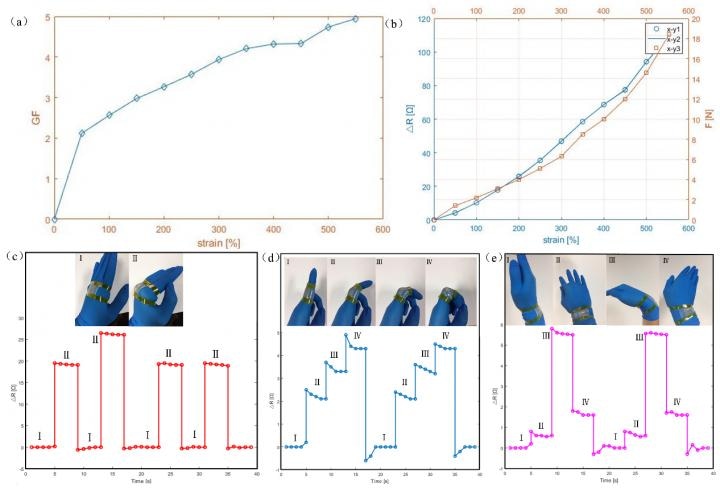Apr 19 2019
A new room-temperature liquid metal-based super-stretchable sensor developed by researchers offers a number of benefits—it is cost-effective, enables facile fabrication, has high repeatability and excellent stretchability, and comes with a high gauge factor (GF) of 4.95.
 (a) The relationship between GF and strain. (b) The relationship of resistance change and strain. Photographs of these sensors attached on the joint (c)/fingers (d)/wrists (e) of different motions, and corresponding resistance change. (Image credit: WANG Lei)
(a) The relationship between GF and strain. (b) The relationship of resistance change and strain. Photographs of these sensors attached on the joint (c)/fingers (d)/wrists (e) of different motions, and corresponding resistance change. (Image credit: WANG Lei)
The latest device possibly takes liquid metal-based sensors to a whole new level. The results of the study have been published in Scientific Reports. A research team, headed by Professor WANG Lei at the Shenzhen Institutes of Advanced Technology (SIAT) of the Chinese Academy of Sciences, performed the study.
Flexible strain sensors have turned out to be a major research area in the fabrication of smart devices and particularly in robotic and wearable medical applications. Sensors like these have extensive possibilities in human motion behavior and electronic skin monitoring systems, and also in human-computer interaction systems.
Comfort, reliability, stability, sensitivity, and stretchability are the key performance parameters for strain sensors. In an effort to realize the most optimum performance, Professor WANG and his colleagues suggested improving the microchannel structures through finite element analysis, or FEA. Subsequently, they designed and developed the sensor consequently.
According to experimental outcomes, the sensor can be expanded to 550% of its original length, bent 180o, and twisted 270o. When strain reached 550%, GF was as high as 4.95; the repeatability error rate was also below 0.1%.
The sensor was used by the team to perform precision detection of wrist, finger, and joint movement, obtaining excellent performance. The researchers’ results demonstrated the excellent potential of the sensor for use in flexible wearable electronic devices.